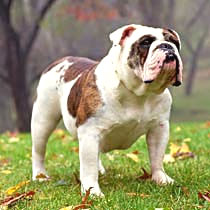|
The Canine Chronicles Directory
Bulldog

The powerful, vigorous Bulldog has a compact and muscular body. The soft, smooth
skin is covered with a short coat that comes in several colors. These colors are
brindle, white, fawn, red, piebald, pale yellow, washed-out red, or any combination
of these colors. The skin should fall in opaque folds around the head, neck and
shoulders. The head should be broad with a flat forehead and cheeks protruding sideways.
The short muzzle should be dark. The corner of the eyes should be at right angle
to the stop. They are dark, set low in the skull and should be as wide apart as
possible. The small ears should be thin and form a rose shape. They should be set
high on the head and far from the eyes. The large, wide nose should have dark pigment
and the distance between the nose and the stop should be small. The massive jaw
should have a protruding upper lip and the lower jaw should be undershot. The teeth
should not be visible when the jaw is at rest. The concise, thick neck merges into
the muscular, wide set shoulder. The shoulders are set far apart and, for greater
stability, slant outwards. The body is broad and low with a deep, ample chest. The
abdomen is tucked up. The bones of the sturdy legs are straight although they appear
bowed. The tail is short, carried low and can either hang down or bend in kinks.
|
|
Temperament
|
Despite their ferocious features, Bulldogs are sweet, devoted, placid, quiet, and
have a great sense of humor. They are gentle and patient with even small children.
Bulldogs should be supervised around small children. They can sometimes not be aware
of their own strength and can knock over a child. They could even break skin with
a playful bite. If introduced at an early age, they will get along with other household
pets. However, they can become quarrelsome with strange dogs. They need human companionship
and thrive on being a part of family life. Bulldogs are usually friendly with strangers
although, if they feel that their family is threatened, they will defend them valiantly.
This breed should be socialized at a young age; otherwise they tend to become dog
aggressive. Since they are a short-faced breed, Bulldogs tend to snore very loudly.
They also have drool and slobber tendencies.
|
|
Height, Weight
|
Male Height: 12-16" ; Weight: 53-55 lbs.
Female Height: 12-16" ; Weight: 49-51 lbs.
|
|
Health Problems
|
Bulldogs are susceptible to numerous conditions, including elbow dysplasia, patellar
dysplasia, hip dysplasia, mange, heat stroke, eye problems, respiratory problems,
small windpipes, snoring and flatulence. Female Bulldogs normally need a cesarean
in order to give birth.
|
|
Living Conditions
|
Bulldogs can live fine in an apartment if they are given sufficient exercise. This
is an indoor breed. They are also weather sensitive.
|
|
Exercise
|
Some adults in this breed would rather not exercise at all. Others are quite active.
They can tend to become overweight, so exercise is important to its health.
|
|
Life Expectancy
|
About 8 years
|
|
Grooming
|
The Bulldog is easy to groom. They are average shedders. Clean between the folds
of the face daily.
|
|
Origin
|
Bulldogs are descendants of an ancient mastiff-like dog called Bullenbeisser. They
were used to guard and attack wild animals in Assyria, Greece, Egypt, and Rome.
The Bullenbeisser was also used by Teutonic and Celtic tribes and came in various
sizes. In England, the larger version of this dog was bred down and, during the
Middle Ages, butchers used them to develop the "Olde English Bulldogge". They were
used to catch bulls for slaughter. The dog's strong jaws and short muzzle afforded
the ability to target the animals nose, cheek, or throat forcing them to their knees
or moving into a barn or slaughterhouse. In the 13th Century, during the reign of
King John, the "Olde English Bulldogge's" were used in bull baiting. This was a
sport in which animals like bulls, horses, or bears are tethered. Dogs were then
released to attack the animal to see if they could overpower it. During the years
in which this sport was popular, dogs were continually developed for this vicious
sport. The breeders would create dogs with these characteristics: tenacity (once
they latched on, they wouldn't let go), impervious to pain, and weight primarily
in the head (if the bull shook the dog this would help from breaking the dog's back).
In 1835, England banned bull baiting and dog fighting. Due to this, Bulldogs nearly
disappeared. Bulldog fanciers used the remaining individuals to resurrect the breed.
Many believe that Bulldogs were crossed with Pugs to help change the appearance
and temperament of the formerly ferocious fighting dog. Breeders have continually
bred selectively to eliminate more aggressive tendencies. They are recognized by
the AKC and the UKC.
|
|
Group
|
AKC Non-Sporting, UKC Companion Dog
|